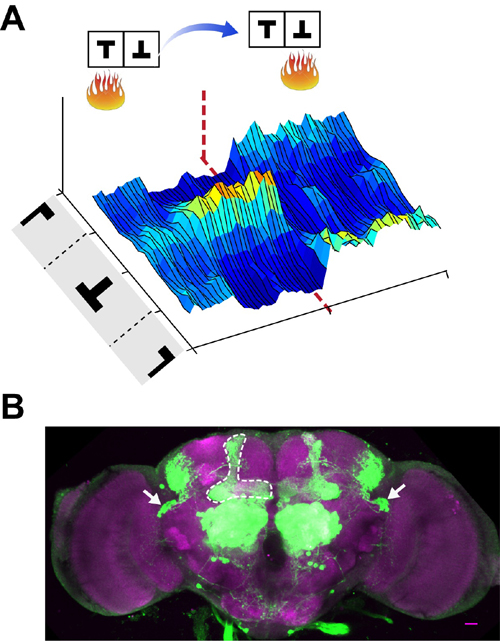Time:2012-08-31
On August 23, 2012, Prof. Aike Guo's research group at the Institute of Neuroscience, Chinese Academy of Sciences, published a research article entitled "A GABAergic inhibitory neural circuit regulates visual reversal learning in Drosophila" in the Journal of Neuroscience.
Behavioral flexibility refers to the ability to change behavioral strategy when facing new and unexpected outcomes. This ability is essential for animals to survive in a dynamically changing environment. Inflexible cognition and behavior are prominent features of prefrontal cortex damage and neuropsychiatric disorders. However, due to the complexity of mammalian brain circuits, the neural mechanism underlying flexible behavior remain poorly understood so far.
In this study, researchers in Prof. Aike Guo's lab first established a visual reversal learning paradigm to assess behavioral flexibility in Drosophila. Flies first learn that one visual stimulus predicts reinforcement, whereas the alternative stimulus does not. Then, the task contingency is unexpectedly reversed by switching the stimulus-reinforcement associations. Using a combination of immunohistochemistry, quantitative PCR and the powerful genetic manipulations available in Drosophila, researchers in Prof. Aike Guo's lab found that inhibitory signaling from a pair of giant GABAergic neurons, named the anterior paired lateral (APL) neurons, onto the mushroom bodies selectively promoted visual reversal learning. Down-regulation of ionotropic GABA receptors in the mushroom body, as well as silencing the synaptic output of the mushroom body, recapitulated the poor behavioral performance of flies with dysfunctional APL neurons. Remarkably, these treatments were specific for visual reversal learning: simple forms of visual learning, including initial learning, extinction, and learning to discriminate between two novel stimuli, remained intact.
These findings established Drosophila melanogaster, a genetic model organism, as a new choice to study the neural circuit mechanism of behavioral flexibility. The relative simplicity of the Drosophila brain provides an obvious advantage for detailed understanding of the neural computation implemented in circuits (e.g. the APL neuron-mushroom body circuit) responsible for flexible behavior. Given the rich genetic arsenal to study gene function in flies, this study also opens the opportunity to gain more insight into behavioral flexibility at the molecular level.
This work was carried out by graduate student Qingzhong Ren and colleagues, under the supervision of Prof. Aike Guo. This study was supported by the 973 Program from the Ministry of Science and Technology of China, the Chinese Academy of Sciences and the National Science Foundation of China.

A. Heat punishment was associated with upright T but switched to invert T upon reversal of stimulus-reinforcement association. The preference of wild-type flies indeed switched after contingency reversal (Red dashed line). B. The ability to behave flexibly in the reversal learning task depends on the normal function of the APL neuron-mushroom body circuit. Arrow: the cell body of the APL neuron. The ramification pattern of the APL neuron in the MB is outlined in dashed lines.
 附件下载:
附件下载: